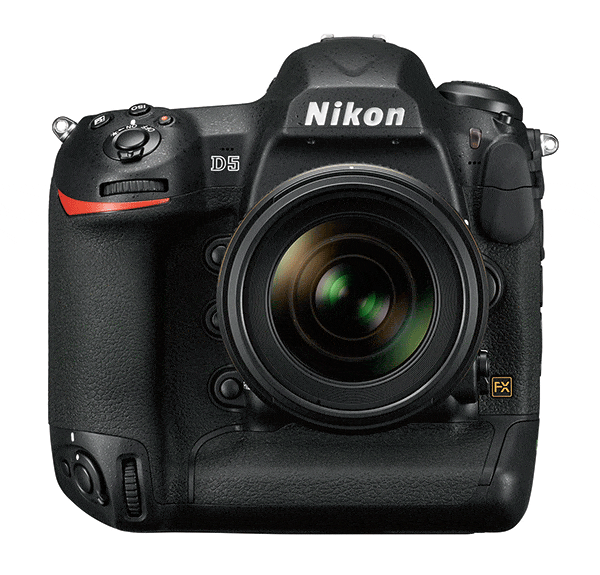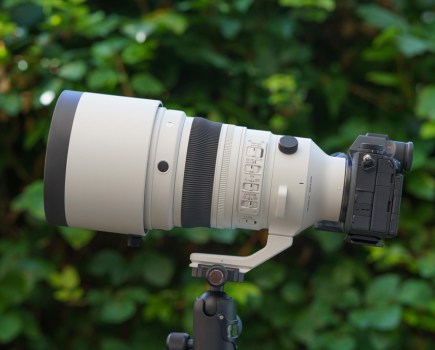Nikon D5 – At a glance
- 20.8-million-pixel, FX-format CMOS sensor
- 153-point AF system
- ISO 100-102,400 (expandable to ISO 50-3,280,000)
- £5,199 body only
In November last year, Nikon announced that it was in the late stages of developing a new flagship model in its FX-format range. A few months down the line and we’ve seen Nikon unveil the D5 – a DSLR that’s set to improve upon the D4S by bringing an improved level of performance to professionals. Although its high price tag of £5,199 body only will put it out of reach of many, the D5 is worthy of a closer look as it introduces Nikon’s latest advances in technology.
Nikon D5 – Features
The D5 is very much a case of ‘out with the old and in with the new’. Unlike the Nikon D4S, which is equipped with a 16.2-million-pixel full-frame sensor, the D5 introduces a brand-new FX-format sensor with an effective resolution of 20.8 million pixels. The new sensor is designed to offer an improved ISO performance and enhanced colour reproduction. This superior sensitivity performance is reflected in the D5’s ISO range, which runs from ISO 100-102,400 with the option to push it to an astounding ISO 3,280,000. In addition, the D5 benefits from Nikon’s new Expeed 5 image processor. This takes the camera to new heights, enabling it to shoot a continuous burst at up to 12fps with AF tracking. There’s also the option to increase this to 14fps with fixed focus and exposure when the mirror is locked up. Other advantages of the D5’s new processor and high-performance buffer allow it to shoot up to 200 NEF (raw) or large JPEG files during a high-speed burst. It’s also said to be 25% more power efficient, with up to 3,780 shots possible from its EN-EL18a battery.

Nikon has raised the bar in terms of autofocus speed and accuracy by introducing a new Multi-CAM 20K autofocus module. This is identical to that found in the D500 and provides users with a complex arrangement of 153 AF points across the frame, 99 of these being of the cross type that are sensitive to both vertical and horizontal detail. The system is configurable to 153-point, 72-point and 25-point settings in continuous AF mode. All 153 focus points are compatible with AF Nikkor lenses with an aperture of f/5.6 or faster, and the 15 central points work with an effective aperture of f/8.
The AF system is coupled to the camera’s 180K-pixel RGB metering sensor – a combination that’s said to set new standards in subject tracking. The D5 also boasts a new 3.2in, 2.36-million-dot LCD monitor that offers touch operation. You can use this to reposition the focus point in live view or acquire preset spot white balance data based on the selected area in the frame. The viewfinder appears similar to the D4S, but there have been a few changes. Magnification on the D5 is down slightly, from 0.72x to 0.70x (when using a 50mm f/1.4 lens focused to infinity) and the viewfinder surround is removable, making it easier to attach accessories such as a rain hood.
For those who want to shoot video, Nikon has equipped the D5 with full HD video capture at 50/60p like the D4S, with the option to record 4K UHD movies (3840×2160) at a frame rate of 30p for a maximum of three minutes. There’s the option to extract 8-million-pixel still images from this 4K footage and create time-lapse footage in 4K resolution. Elsewhere, the D5 is furnished with a SuperSpeed USB 3.0 port and faster Ethernet connection.
Nikon D5 – Build and handling

A dissected D5 was displayed behind glass on the Nikon stand at the CES technology show
The body of the D5 is constructed from magnesium alloy with full weather sealing, and offers the same built-like-a-tank feel in the hand that we’re used to from Nikon’s flagship models. Although it may look similar to the Nikon D4S, the D5’s ergonomics have been tweaked to improve operation. There’s a new Fn2 function button beside the lens mount and a third Fn3 button is found at the rear beneath the OK button. The drive mode button is now found where the ISO button once was and Nikon has removed the microphone record button, replacing this with the repositioned info button. The mode button has also shuffled over to the left where the bracketing and metering buttons are positioned. This has freed up space for an ISO button directly behind the shutter, which feels logical from behind the camera.
The Nikon D5 is available for pre-order and is expected to hit UK shores in March, at a similar time to when we can expect the D500 to arrive.

Nikon D5 – Does the three-minute 4K limit matter?
One of the key features of the Nikon D5 is its ability to shoot 4K UHD video footage. However, a closer inspection of the specification reveals that it can only shoot at this resolution for a maximum of three minutes. Many videographers bemoaned this as not being long enough. The argument is that while the times are rare that you would use a clip longer than three minutes, for situations such as interviews or live performances you need to have the option to record for longer, even if the footage eventually used is only a few seconds long.

Users of the Nikon D5 can’t record 4K UHD video for longer than three minutes
This begs the question – is the three-minute maximum record time on the Nikon D5 a deal breaker? The answer, as with most things to do with photography and filmmaking, is that it entirely depends on what you shoot. If you are doing live music or sports events, or recording a documentary with lots of interviews, then the Nikon D5 isn’t going to be for you, at least not if you want to shoot in 4K (the camera can shoot for as long as 10 or 20 minutes in 1080p, depending on the quality of footage). However, for narrative work or travel documentaries, then the D5 should be suitable. Also, let’s not forget that the camera has a live HDMI output that allows for 4:2:2 footage to be captured to an external recorder, although we don’t yet know at what point the camera will turn off due to overheating.
During our interview with Nikon at CES 2016, we asked if the company could tell us why the Nikon D5 is limited to recording three minutes of 4K footage and whether it has anything to do with the weather sealing of the camera? Nikon replied, ‘No, it has nothing to do with the weather sealing of the camera. It’s a matter of processing and the heat that is generated during processing. We work with a crop on the sensor for the 4K, however the primary concept and idea of this camera is not about video. The D500 goes the full half an hour (29mins 59secs), but the focus was different here. Based upon the feedback of the users of this camera [the Nikon D5], who are mostly journalists and sports photographers, they tend to record short snippets rather than lengthy live coverage’.
Nikon D5 – First impressions
The D5’s arrival has been talked about for a while, but this doesn’t take anything away from what looks and feels like Nikon’s best DSLR to date. It manages to improve upon the resolution of the D4S and we’re hopeful of seeing impressive gains in ISO performance when we come to test it. During an interview with Nikon (see page 9), Dirk Jesper, product manager for professional products and product planning at Nikon Europe, told us that although the ISO extends beyond three million this will not be the main focus for professional sports photographers and journalists who frequently find themselves working in poor light conditions. He went on to say ‘the main focus will be from ISO 6,400-12,800’.
https://link.brightcove.com/services/player/?bctid=4709860476001
The D5’s immediate autofocus response combined with the vast number of AF points around the frame is outstanding, and the staggering speeds of continuous shooting left me somewhat mesmerised after my hands-on experience. For professionals who demand nothing but the best accuracy, speed and performance, the D5 appears to tick all the right boxes. Although we have yet to put it through the lab and test it thoroughly, the new features seem as though they justify an upgrade from the D4/D4S, and there’s plenty for professional photographers to get excited about. To give credit where credit is due, it’s also fantastic to see Nikon employing advanced features such as the 153-point autofocus system from the D5 into other DSLRs in the line-up such as the D500. Serious enthusiasts looking to progress from an entry-level model, or D7200, say, now have the same focusing performance available to them as professionals using the Nikon D5.








